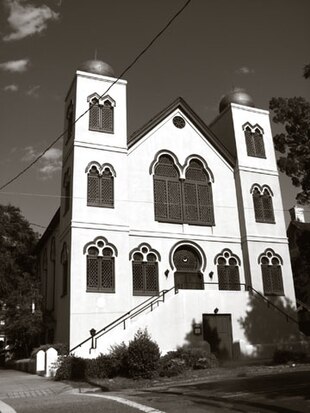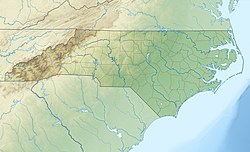
A synagogue, also called a shul or a temple, is a place of worship for Jews and Samaritans. It has a place for prayer where Jews attend religious services or special ceremonies such as weddings, bar and bat mitzvahs, choir performances, and children's plays. They also have rooms for study, social halls, administrative and charitable offices, classrooms for religious and Hebrew studies, and many places to sit and congregate. They often display commemorative, historic, or modern artwork alongside items of Jewish historical significance or history about the synagogue itself.

Congregation Emanu-El of New York is the first Reform Jewish congregation in New York City. It has served as a flagship congregation in the Reform branch of Judaism since its founding in 1845. The congregation uses Temple Emanu-El of New York, one of the largest synagogues in the world.

Synagogue architecture often follows styles in vogue at the place and time of construction. There is no set blueprint for synagogues and the architectural shapes and interior designs of synagogues vary greatly. According to tradition, the Shekhinah or divine presence can be found wherever there is a minyan, a quorum, of ten. A synagogue always contains an Torah ark where the Torah scrolls are kept, called the aron qodesh by Ashkenazi Jews and the hekhal by Sephardic Jews.

The Leopoldstädter Tempel, also known as the Israelitische Bethaus in der Wiener Vorstadt Leopoldstadt, was a Jewish congregation and synagogue, located on Tempelgasse 5, in Leopoldstadt, in the 2nd district of Vienna, Austria. Completed in 1858, the synagogue was destroyed as a result of Kristallnacht. A monument marks the location of the former synagogue.

Moorish Revival or Neo-Moorish is one of the exotic revival architectural styles that were adopted by architects of Europe and the Americas in the wake of Romanticist Orientalism. It reached the height of its popularity after the mid-19th century, part of a widening vocabulary of articulated decorative ornament drawn from historical sources beyond familiar classical and Gothic modes. Neo-Moorish architecture drew on elements from classic Moorish architecture and, as a result, from the wider Islamic architecture.
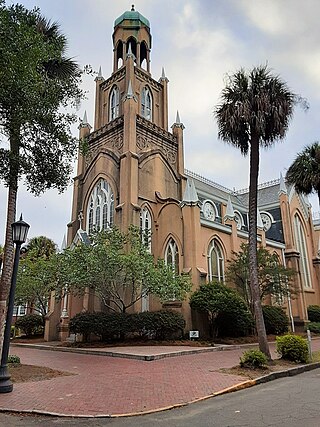
Congregation Mickve Israel is a Reform Jewish congregation and synagogue located at 20 East Gordon Street, Monterey Square, in Savannah, Georgia, in the United States. The site also contains a Jewish history museum.

The Wilshire Boulevard Temple, known from 1862 to 1933 as Congregation B'nai B'rith, is a Reform Jewish congregation and synagogue, located at 3663 Wilshire Boulevard, in the Wilshire Center district of Los Angeles, California, in the United States. Founded in 1862, it is the oldest Jewish congregation in Los Angeles.

B'nai Israel Synagogue is a Modern Orthodox synagogue located in the historic Jonestown neighborhood, near downtown and the Inner Harbor of Baltimore, Maryland, in the United States. The synagogue is one of the oldest synagogue buildings in the United States.

Congregation Beth Israel is a Reform Jewish congregation and synagogue, located at 1931 NW Flanders Street, Portland, Oregon, in the United States.

Temple Gemiluth Chessed is a former Reform Jewish congregation and synagogue, located at 706 Church Street, in Port Gibson, Mississippi, in the United States. Built in 1892, it is the oldest congregation in the state and the only building completed in the Moorish Revival style. The congregation was founded in 1870 by a community of Jewish immigrants from German states and Alsace-Lorraine. Due to declining population as people moved to larger urban areas, the congregation closed in 1986.

Temple Adas Israel is an historic Reform Jewish synagogue located at the intersection of Washington and College streets in Brownsville, West Tennessee. Built in 1882 by German Jewish immigrants and descendants, it is the oldest synagogue building in Tennessee and one of fewer than one hundred surviving 19th-century synagogues in the country. On January 19, 1979, Temple Adas Israel was added to the National Register of Historic Places.
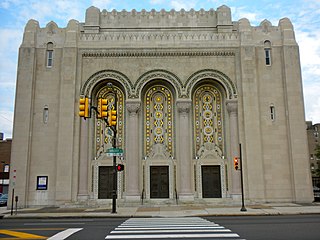
Congregation Rodeph Shalom, is an historic Reform Jewish congregation and synagogue located at 615 North Broad Street, Philadelphia, Pennsylvania, in the United States. Established in 1795, it is the oldest Ashkenazic synagogue in the Western Hemisphere. It is noted historically for its leadership of the Reform movement among American Hebrew congregations, for its spiritual influence upon international Jewry, and for its unique 1927 Byzantine and Moorish Revival synagogue building, with Art Deco finishes, on North Broad Street, listed on the National Register of Historic Places since 2007.
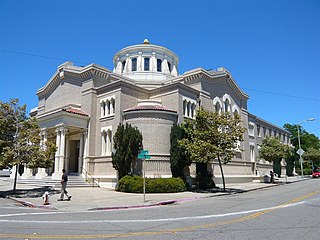
Temple Sinai is a Reform Jewish congregation and synagogue located at 2808 Summit Street in Oakland, California, in the United States. Founded in 1875, it is the oldest Jewish congregation in the East San Francisco Bay region.

Congregation Mishkan Israel is a Reform Jewish congregation and synagogue, located at 785 Ridge Road, in Hamden, Connecticut, in the United States. Founded in 1840, it is the oldest Jewish congregation in both Connecticut and New England, and the 14th oldest continuous operating synagogue in the United States.

Ahavath Beth Israel, officially Congregation Ahavath Beth Israel, is a Reform Jewish congregation and synagogue, located at 11 North Latah Street, in Boise, Idaho, in the United States. Its 1896 building is amongst the oldest synagogues in continuous use west of the Mississippi River. The congregation is affiliated with the Union for Reform Judaism.

Temple House of Israel is a Reform Jewish congregation and synagogue located at 15 North Market Street, in Staunton, Virginia, in the United States. Founded in 1876 by Major Alexander Hart, it originally held services in members' homes, then moved to a building on Kalorama street in 1885, the year it joined the Union for Reform Judaism.

Temple Israel is a Reform Jewish synagogue located at 2323 Fremont Avenue South, in Minneapolis, Minnesota, in the United States. Founded in 1878, it is the oldest synagogue in Minneapolis and one of the largest Jewish congregations in the United States.

Temple Israel of the City of New York is a Reform Jewish congregation and synagogue located at 112 East 75th Street, on the Upper East Side of Manhattan in New York City, New York, United States. The congregation was incorporated by German Jews in 1873.
Arthur Bluethenthal, nicknamed "Bluey", was an All-American football player for Princeton University, who died in combat fighting for France in World War I.
